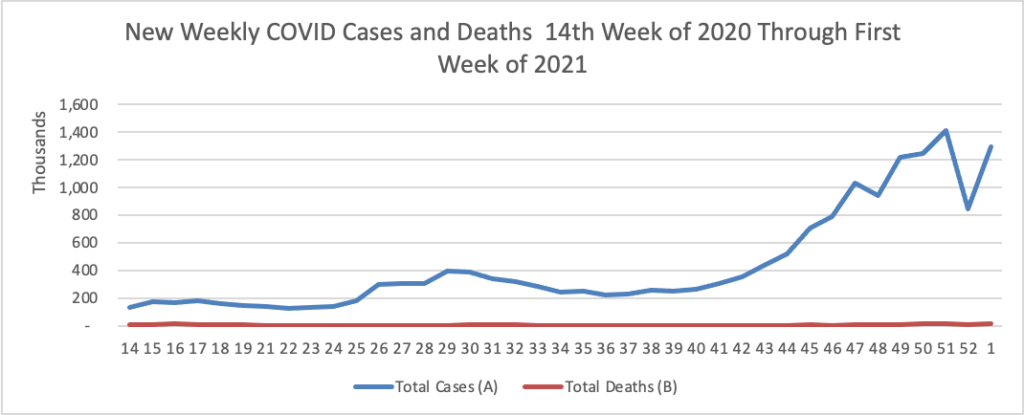Based on the CDC’s Cases in the U.S. website, here is the FEHBlog’s chart of new weekly COVID-19 cases and deaths over the 14th week of 2020 through 1st week of this year (beginning April 2, 2020, and ending January 6, 2021; using Thursday as the first day of the week in order to facilitate this weekly update):

and here is the CDC’s latest overall weekly hospitalization rate chart for COVID-19:

The FEHBlog has noted that the new cases and deaths chart shows a flat line for new weekly deaths because new cases greatly exceed new deaths. Accordingly here is a chart of new COVID-19 deaths over the period April 2, 2020 through January 6, 2021.

Because this week the CDC began to update its COVID-19 vaccinations data on a daily basis the FEHBlog was able to create this vaccines distributed and initially administered over the 51st week of 2020 through the first week of 2021 (December 23, 2020 through January 6, 2021):

Over the past four daily reports, the number of initial COVID vaccines administered increased steadily from 273,209 doses on January 4 to 748,313 doses yesterday. Per the AMA’s Morning Rounds
USA Today (1/6, Weintraub) reports HHS Secretary Alex Azar told governors to vaccinate as many people against SARS-CoV-2 as possible and warned to not let “perfection be the enemy of the good,” referring to priority plans. Azar said that with up to 70% of distributed vaccines still on shelves, states should focus on vaccinating the most people rather than prioritizing certain groups.
Today’s Fluview continues to report that “Seasonal influenza activity in the United States remains lower than usual for this time of year.”
UPI reports today that
At least half of COVID-19 transmission globally may have been caused by symptom-free infected people unknowingly spreading the virus to others, a study published Thursday by JAMA Network Open found.
In addition, nearly one in four cases of virus spread involves infected people who remain asymptomatic, the researchers estimated.
The findings highlight the importance of public health measures such as social distancing, mask-wearing and hand-washing — even for people who don’t feel sick — in preventing the spread of the virus, they said.
Mercer writes about the most pressing requirement of the Consolidated Appropriations Act – preparing and document comparative analyses to document compliance with the non-quantitative treatment limitations requirements under the federal mental health parity law. Mercer notes that
In case plan sponsors need more motivation to step up compliance efforts, we’re also seeing more litigation against plan sponsors and insurers alleging MHPAEA violations and breach of fiduciary duties under ERISA. In late 2020, in Wit v United Behavioral Health (UBH), a class action lawsuit ended with a decision by a federal court granting the plaintiffs the full extent of relief they requested and requiring UBH to reprocess nearly 67,000 mental health and substance use disorder (MH/SUD) benefit claims that were denied between 2011 and 2017. The federal court held that UBH breached its fiduciary duty to plan participants based on its use of overly restrictive medical necessity guidelines that resulted in the improper denial of more than 67,000 MH/SUD claims. This is just one example of the more than 100 lawsuits filed in the past several years alleging various MHPAEA and ERISA claims review violations relating to exclusions for ABA therapy, coverage for residential and other treatment facilities, medical necessity standards, and other items.
